Finally harvested and rippled the flax. Not the best year (too dry early on and not enough weeding!) but but the best group of harvesters!
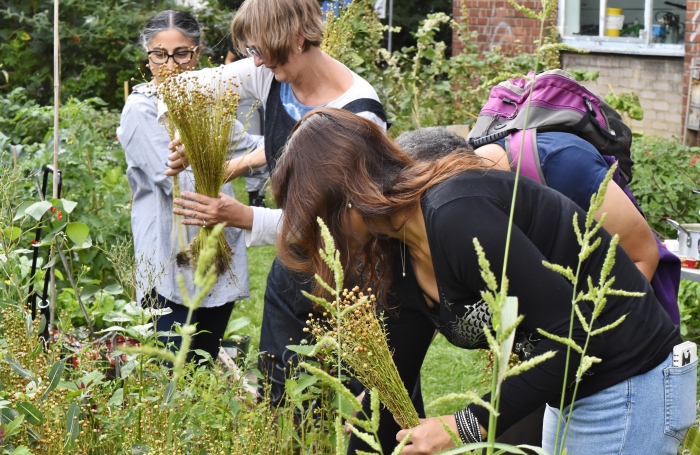

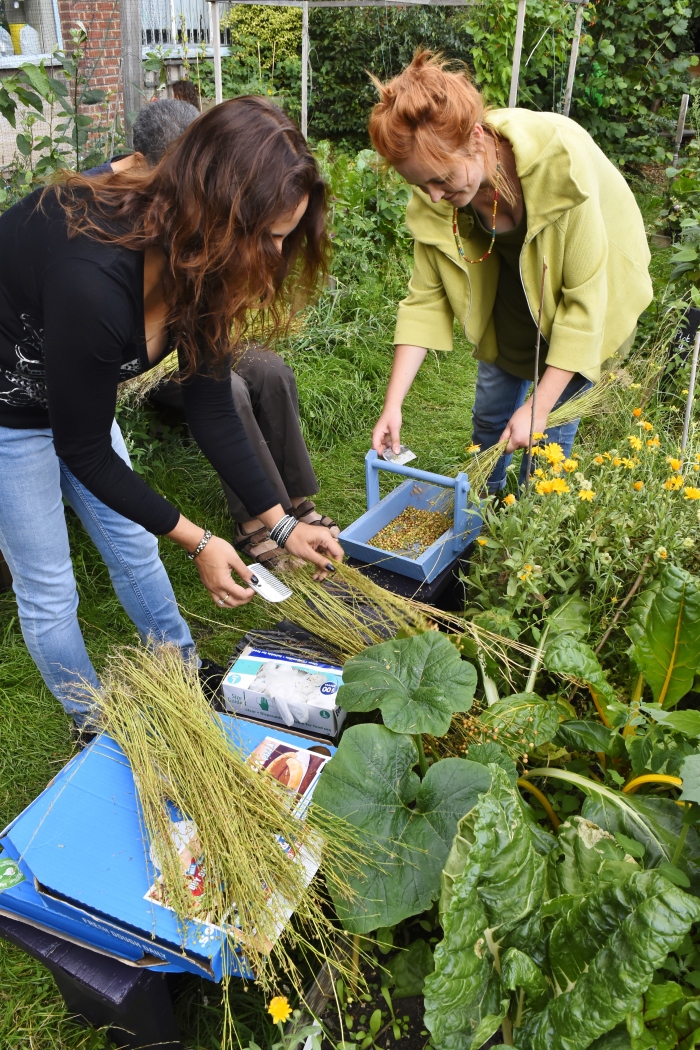


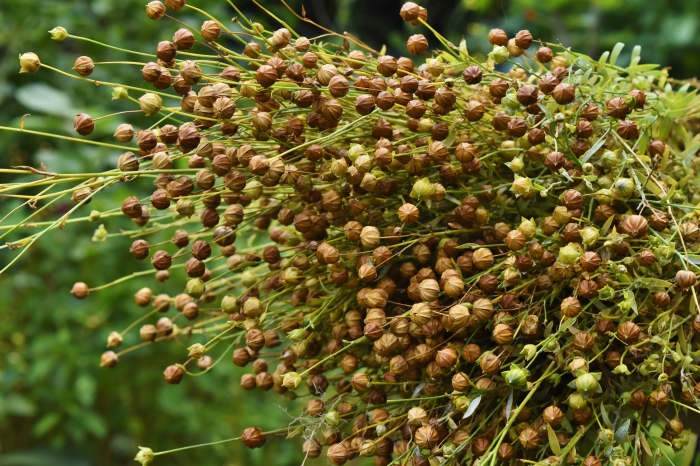



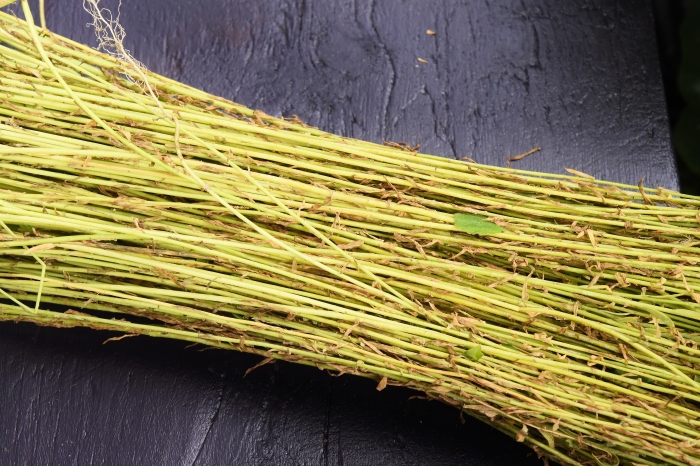
Finally harvested and rippled the flax. Not the best year (too dry early on and not enough weeding!) but but the best group of harvesters!










H
I went bleary-eyed to Lister Community School in Newham the other day – not used to an early start these days. The class had been looking at sustainability so I made a pincer approach of natural dyeing and flax. This is the work they produced in class. I was so impressed that they were actually listening!
One of the girls also wrote a piece for the school blog. http://www.lister.newham.sch.uk/specialist-curriculum-textiles-may/
This is the key to a technique for flax spinning we learnt last night: dampen your knee. What’s great about our flax to thread sessions is that the people who come are so skilled and cover such a wide range of interests from sowing to… er… sewing. Last Thursday at the London College of Fashion we had growers from community gardens and allotments, spinners and knitters, technical innovators and fashion designers. We honed two methods of spinning; one using the drill method. I now know you must wet the fibre to help it bond to itself and that you must turn the drill anti-clockwise to make the magic really work. The other technique, which gardener, designer and teacher Dina demonstrated, used no equipment apart from the above-mentioned damp knee, and involved rolling the heckled fibre on a leg see our Knee-Spinning video. We also got an excellent new model for our garment – Benjamin. He wears it very well. Kellie also models the string she made – as a stylish belt.
I met Aaron through Twitter. Last year in the midst of the flax project, I scoured the electronic world for spinners and we found each other. He was willing to spin the flax and, not only that, spin in primary schools with scores of excited children buzzing round him. And then repeat.
He came to the little exhibition Zoe Burt put on at Brockwell Park House – featuring the garment. It was such a joy to see him again and relive those rather fraught sessions at the schools and to remind ourselves what we’d achieved. We also marvelled at the work of spinners. Without them, no fabric. It doesn’t matter how much processing you do to fibre, without someone to twist it, there is no thread, no strength. That makes spinners powerful and reinforces the fact that a spinster was, because of her skill, able to make a living. She didn’t need to get married. She was independent. We should reclaim the word from its negative associations – but that is another matter.
Back to Aaron. He’d brought his spinning wheel to the exhibition and spun away – showing some visitors how to do it, too. He works for TfL to make a living but his love is spinning and knitting and that makes him happy. I said he was the Philip Larkin of the knitting world – supporting his art with a mundane job. Making beautiful things, working hard and being quite content with that.
Thanks, Aaron. It was a great collaboration.
He seems to be willing to do it again so hopefully we can continue our partnership and throw ourselves back into those classrooms and break, scutch, heckle and spin with those buzzing children. Hurrah!
We’re getting ready for the RHS’s Secret Sunday on 1st March. They’ve asked us to display our London-grown garment. It will be its first public appearance since it was made. It’s actually being reknitted at the moment so we hope it will have sleeves! We’ll be giving a talk about the project at 10.45 so come and see (and even touch) it and ask us how we did it.
Throughout the day we’ll be running a drop-in dye workshop and we’ll be talking about our new project – to grow community string.
https://www.rhs.org.uk/shows-events/rhs-london-shows/secret-sundays

We didn’t really think it through before embarking on a project to grow a piece of clothing entirely in London. If we had thought it through, we might not have started as it was a year-long labour of love and faith. But we were inspired by the idea of the threads that bind us together in the city. We wanted to show, through a piece of material, that individually we can come together to make something that we can’t do on our own.
Until the introduction of cotton and the industrial revolution, linen production was widespread in Britain and Ireland. Indeed, it was the first textile crop grown by man – 10,000 or so years ago. Its peak here was probably in the 17th and 18th centuries. People would have grown it for their own needs and it was also raised and processed on a large scale. But it takes a lot of work – and expertise. All those centuries of flax production being commonplace and domestic made everyone an expert – or at least aware of the plant and its uses. No longer. We had to start from the beginning. We had to learn about the plant’s many properties and work out ideal growing conditions, to dew or water ret, the best way of heckling, do we need a distaff for spinning? What is a distaff? Would this toy giraffe do?
We made mistakes and wasted a lot of time and flax getting it wrong and lost people and plants on the way, but we had some great days. A memorable one was sowing a patch next to the River Lea in Hackney. On a sunny morning we met river dwellers and land lubbers who spoke to each other about common concerns. We talked over cups of tea to small children, dog walkers, curious passers-by and the odd loiterer. Already the flax was bringing us together.
And the school workshops were full of excitement and energy – as well as learning. We worked with five Hackney and Tower Hamlets primary schools (300+ noisy children!) thanks to the local school gardener’s (Cassie Liversidge’s) own enthusiasm. They rippled, retted, broke, scutched, heckled and even spun the flax. If nothing else, they learned that thread comes from plants and takes a lot of effort. They fitted flax production into their lessons – from science to the Iron Age. Cassie said it was a “fantastic ‘living history’ lesson for the pupils and they have loved to be involved in it”.
This project brought a huge number of (sometimes surprising) people together – from those children in London to Hebrew Bible publishers in Jerusalem and a weaver in Crete. In between were community gardens, housing estates, city farms, Children’s Centres, Permaculturalists, fashion students, knitters, weavers and, thanks to the Guild of Spinners, Weavers and Dyers and Twitter, two spinners (Christine Rowe and Aaron Fletcher) who were willing to learn about the demands of turning hanks of hair-like fibre into thread.
Throughout the project we were tugged back into our pasts and our fairy tale memories – from the ancient boredom and sociability of harvesting, to gazing at the huge pile of flax straw and wishing Rumpelstiltskin was nearby. Similarly, there was a fairy tale quality to our own spinning. It didn’t matter how much we processed, our pile of thread never seemed to grow any bigger. But eventually we handed our yarn (about 400g) over to knitters at the London College of Fashion. They made a top designed to bring out the great variability of the thread – made by so many people.
But it wasn’t really about the final product; it was about the threads that bind us.
If you’d like to find out more, or to take part in our slightly less ambitious project this year – to grow string – email kate@cordwainersgrow.org.uk








In that no-man’s-land between Christmas and New Year, we managed to winkle a good handful of people from the warmth of their homes into the cold mid-winter to try to reduce our still large pile of flax to thread (where IS Rumplestiltskin when you need him?). Two people, Moira and Catherine, came from afar (Woking and somewhere further than Richmond) in spite of the bus strike. Moira is now an expert as she’s been to three workshops and is even starting to develop her own tools. Catherine was a novice but keen to learn about natural fibre and dyes. We were also very happy to see Charlotte and Doug (formerly of this parish) who’ve been working on organic farms in Britain and Spain.
It was cold but bright and we spun 56 metres – mostly using the hand drill method. Doug made a lovely fire (don’t tell) and we drank lots of tea and HopCord, the beer made by the People’s Park Tavern with our hops. Yum.
This little skein of linen was made by children at schools in Hackney and Tower Hamlets and a number of people from around London. It was grown in London, processed here, spun (in Fulham) by Christine Rowe and dyed with madder grown at Cordwainers Garden. It’s a wonderful thing.
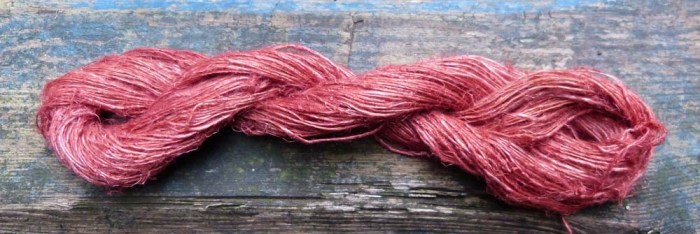
We’ve been doing a series of workshops to turn our flax into thread. Here’s a short blog by Antoinetta, who came along to our drop-in day last week.
“Before I went to the flax workshop, I had no idea that linen is made from the cellulose fibers that grow inside the stalks of the flax plant. When on Tuesday I arrived at the lovely garden in the heart of London, I found many volunteers helping with a project which tries to connect people and place through a greater awareness of the environment.
I did not know anybody but a warm atmosphere made me feel immediately comfortable.
It was a very good experience where I learnt about part of the processing of flax and where I met many interesting people to chat to.
Delicious refreshments included soup, bread and an amazing cake with tea and herbal tea were provided!
Thanks for everything”
We took over the canteen at the London College of Fashion on Saturday and found the quality of the flax (or it could have been the retting or drying) was much better than last time. .








